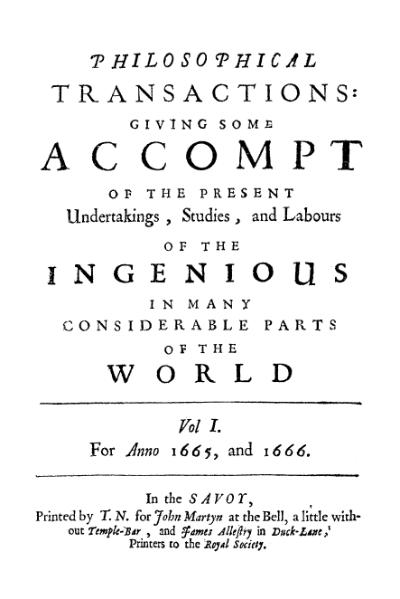1665 chemistry update
01 November 2011 - Open access
 The Royal Society last week announced the journal Philosophical Transactions of the Royal Society from now on is open access for the volumes published between 1665 and 1941 (Link). That is good news for those who think charging money by publishers for scientific articles more recent than 6 months is reasonable, charging money for older articles is questionable and charging money for one hundred year old publications is downright greed (articles priced on average between 20 and 40 dollars per article).
The Royal Society last week announced the journal Philosophical Transactions of the Royal Society from now on is open access for the volumes published between 1665 and 1941 (Link). That is good news for those who think charging money by publishers for scientific articles more recent than 6 months is reasonable, charging money for older articles is questionable and charging money for one hundred year old publications is downright greed (articles priced on average between 20 and 40 dollars per article).
The odd thing about the announcement is that copies of the transactions are all over internet including wikimedia commons here so where exactly is the novelty? In any case it has been a joy to be able to read the chemistry contributions from that issue 1 from the year 1665.
Take for example the account by Robert Moray (one of the Chemical Society founding fathers) on page 45 on the Mineral of Liege (look a 365 year old DOI! => DOI, Huh?, no wait). In it he describes the (industrial?) production of brimstone and vitriol from said mineral by breaking it in little pieces and applying lot of heat. The process starts to make sense if the mineral is pyrite (FeS2), the city is Liege, brimstone is sulfur and vitriol iron sulfate and/or sulfuric acid. When the sulfur is extracted the residue is collected and soaked in water until an egge will fwim upon the liquor. Then more boiling takes place and then the copperas (used as an ink) will separate out as pyrite's oxidation product leaving aqueous sulfuric acid behind.
On page 10 of the same issue Society co-founder and scientist Robert Boyle (Boyle's law) completely wasts his colleagues time (and countless scientists would follow his example) by reporting on a Very Odd Monstrous Calf (DOI). On a more serious note Boyle also reports on a new lead ore which possibly is Galena or lead sulfide. According to Boyle the ore is peculiar because it is not mixed with any other metal. The sample that eventually made it to Boyle originated from the Upper Palatinate (Germany). Because of the Thirty Years' War that had raged in the region, this sample was found not in a mine but on the ground where the last inhabitants had left it before they fled.
By the way, you still have to pay 35 dollars for page 1 volume 1 (1879) of the Journal of the American Society (DOI), you still have to pay up for page 1 volume 1 of Liebigs Annale (1832) (DOI) and page 1 volume 1 (1957) of Tetrahedron (Elsevier) (DOI) will cost you 41 dollar. Publishers: is it about time to make some policy changes?
